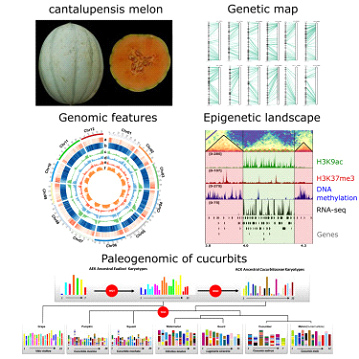The genome of melon Charentais decoded
Cucumis melo presents a great diversity of horticultural groups, the cantaloupe melon, known in France under the name of Charentais, being the most cultivated type. It was introduced to France by Charles VIII in the late 15th century. Using a combination of sequencing technologies, the FloCad Team of Abdelhafid Bendahmane, in collaboration with LRSV, CNRGV, GDEC and GAFL laboratories have assembled the genome of the Charentais melon. Integration of RNA-seq, MeDip-seq, ChIP-seq, and Hi-C data revealed a widespread compartmentalization of the melon genome, segregating constitutive heterochromatin and euchromatin. Genome-wide comparative and evolutionary analysis between the different melon botanical groups identified Charentais mono genome as being increasingly more divergent from Harukei-3 (reticulatus), Payzawat (inodorus), and HS (ssp. agrestis) genomes. To assess the paleohistory of the Cucurbitaceae, we reconstructed the ancestral Cucurbitaceae karyotype and compared it to other sequenced cucurbit genomes. In contrast to species that experienced massive chromosome shuffling, melon has retained the ancestral genome structure. This work, published in iScience, provides comprehensive genomic resources and new insights in the diversity of melon horticultural groups and evolution of cucurbits.

Mise en ligne le 08/03/2022
